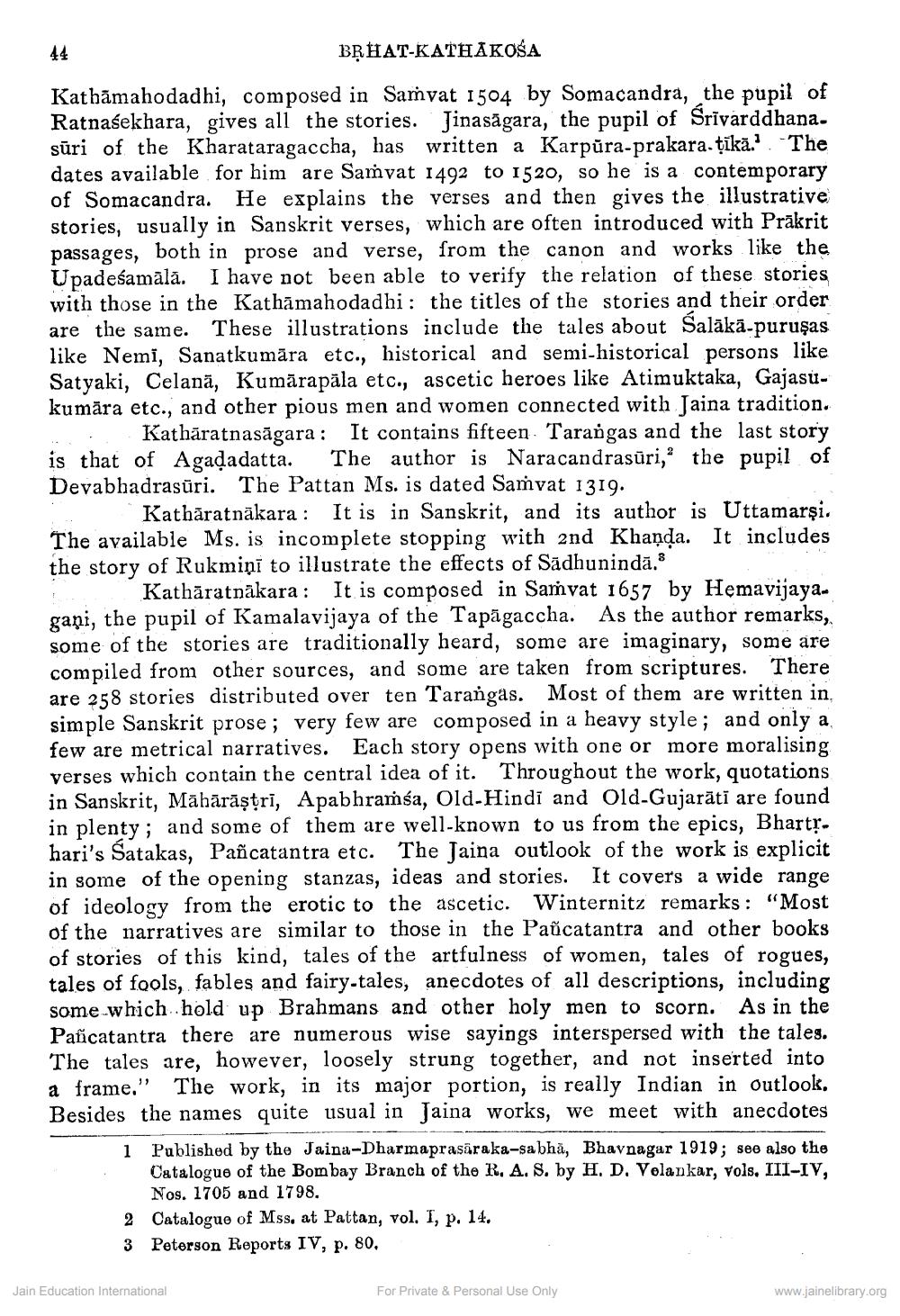________________
BņHAT-KATHÅKOŠA Kathāmahodadhi, composed in Samvat 1504 by Somacandra, the pupil of Ratnasekhara, gives all the stories. Jinasāgara, the pupil of Srīvarddhana. sūri of the Kharataragaccha, has written a Karpura-prakara.tikā." The dates available for him are Samyat 1492 to 1520, so he is a contemporary of Somacandra. He explains the verses and then gives the illustrative stories, usually in Sanskrit verses, which are often introduced with Prākrit passages, both in prose and verse, from the canon and works like the Upadeśamālā. I have not been able to verify the relation of these stories with those in the Kathāmahodadhi: the titles of the stories and their order are the same. These illustrations include the tales about Salākā-puruşas like Nemi, Sanatkumāra etc., historical and semi-historical persons like Satyaki, Celanā, Kumārapāla etc., ascetic heroes like Atimuktaka, Gajasukumāra etc., and other pious men and women connected with Jaina tradition.
. Kathāratnasāgara: It contains fifteen Tarangas and the last story is that of Agadadatta. The author is Naracandrasūri, the pupil of Devabhadrasūri. The Pattan Ms. is dated Samvat 1319.
.: Kathāratnākara : It is in Sanskrit, and its author is Uttamarşi. The available Ms. is incomplete stopping with and Khaņda. It includes the story of Rukmiņi to illustrate the effects of Sādhunindā.
Kathāratnākara: It is composed in Saṁvat 1657 by Hemavijaya. gani, the pupil of Kamalavijaya of the Tapāgaccha. As the author remarks, some of the stories are traditionally heard, some are imaginary, some are
piled from other sources, and some are taken from scriptures. There are 258 stories distributed over ten Tarangas. Most of them are written in simple Sanskrit prose; very few are composed in a heavy style; and only a few are metrical narratives. Each story opens with one or more moralising verses which contain the central idea of it. Throughout the work, quotations
anskrit, Māhārāştri, Apabhramsa, Old-Hindi and Old-Gujarāts are found in plenty; and some of them are well-known to us from the epics, Bhartr. hari's Satakas, Pañcatantra etc. The Jaina outlook of the work is explicit in some of the opening stanzas, ideas and stories. It covers a wide range of ideology from the erotic to the ascetic. Winternitz remarks: "Most of the narratives are similar to those in the Pañcatantra and other books of stories of this kind, tales of the artfulness of women, tales of rogues, tales of fools, fables and fairy-tales, anecdotes of all descriptions, including some which hold up Brahmans and other holy men to scorn. As in the Pañcatantra there are numerous wise sayings interspersed with the tales. The tales are, however, loosely strung together, and not inserted into a frame." The work, in its major portion, is really Indian in Outlook, Besides the names quite usual in Jaina works, we meet with anecdotes
1 Published by the Jaina-Dharmaprasaraka-sabha, Bhavnagar 1919; see also the
Catalogue of the Bombay Branch of the R. A. S. by H. D. Volankar, vols. III-IV,
Nos. 1705 and 1798. 2 Catalogue of Mss, at Pattan, vol. I, p. 14. 3 Peterson Reports IV, p. 80.
Jain Education International
For Private & Personal Use Only
www.jainelibrary.org




